Trees Birds Mammals Fish Amphibians Reptiles
Wild Algarve
Bookshop
Cortinarius camphoratus (Fr. ) Fr. - Goatcheese Webcap
Phylum: Basidiomycota - Class: Agaricomycetes - Order: Agaricales - Family: Cortinariaceae
Distribution - Taxonomic History - Etymology - Toxicity - Identification - Reference Sources
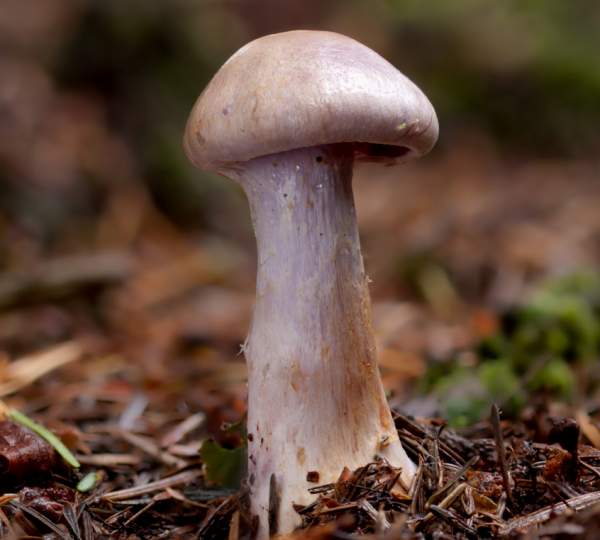
Cortinarius camphoratus is found in late summer and autumn growing in coniferous woodland. From its appearance it is not easily separated from several other pallid webcap mushrooms, but fortunately this woodland mushroom has a very distinctive smell.
Distribution
A rare species in Britain and Ireland, the Goatcheese Webcap is found also in many parts of mainland Europe and in North America.
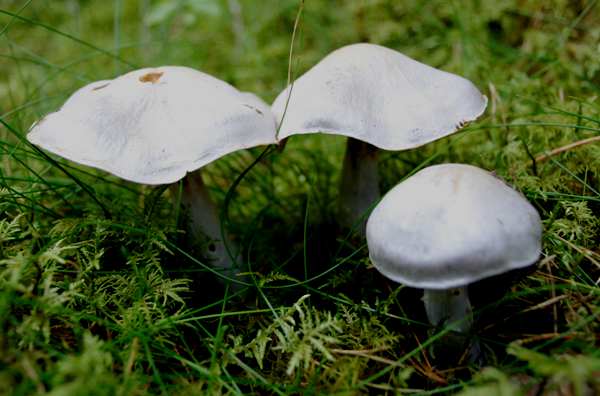
Taxonomic history
When in 1821 the great Swedish mycologist Elias Magnus Fries described this webcap mushroom in his Systema Mycologicum he gave it the scientific name Cortinarius camphoratus; this was the name sanctioned via his Epicrisis Systematis Mycologici: seu synopsis hymenomycetum of 1838.
Synonyms of Cortinarius camphoratus include Cortinarius amethysteus (Schaeff.) Quél., Agaricus amethystinus Schaeff., Agaricus camphoratus Fr., and Cortinarius hircinus Fr.
Etymology
The generic name Cortinarius is a reference to the partial veil or cortina (meaning a curtain) that covers the gills when caps are immature. In the genus Cortinarius most species produce partial veils in the form of a fine web of radial fibres connecting the stem to the rim of the cap.
It's not hard to work out that the specific epithet camphoratus refers to a camphor-like odour, and to those of us of 'a certain age' that suggests the smell of mothballs; however, with extensive use of synthetic fibres clothes moths are not such a problem nowadays, and not everyone recognises the smell of camphor (despite its many other uses in medicine, fireworks etc). The common name adopted in the British Mycological Society's English Names of Fungi refers to the somewhat similar odour of cheese made with goat's milk.
Toxicity
This mushroom is reported by some authorities to be edible, while others say that it is poisonous. We therefore recommend that the Goatcheese Webcap should most definitely not be gathered for eating.
Identification guide
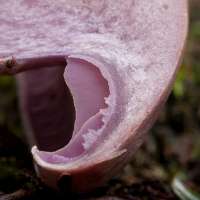 |
Cap
Young caps are convex with an inrolled margin, later flattening as
they expand but often retaining a shallow umbo. The cap diameter varies from 4 to 10cm at maturity.
At first a beautiful pale ochre flushed with lilac, the cap surface is finely fibrillose; the cap centre turns golden ochre and becomes more smooth and shiny with age.
The flesh of cap and of the stem are a beautiful lilac or pale purple colour. |
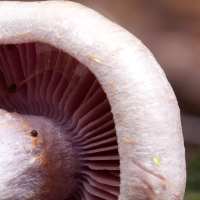 |
Gills
The adnate gills are pale lilac at first, turning rusty brown as the spores mature.
Stem
5-10com long and 1-2cm in diameter, the stem of the Goatcheese Webcap is the same colour as the cap; it is covered with fine longitudinal fibrils below the ring zone, which becomes more evident with age as it gathers a fine dusting of falling rust-brown spores. The stem is solid, not hollow. |
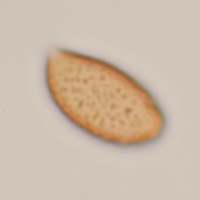 |
Spores
Ellipsoidal, finely warty; 9-11 by 5-6μm.
Spore print
Rusty brown. |
Odour/taste |
Odour reminiscent of camphor, mature goat's cheese, rotting potatoes or (some people say) sweaty feet! Taste not significant. |
Habitat & Ecological role |
Often on acid soil, in coniferous woodland, where it is mycorrhizal with spruces (Picea species) and firs (Abies species). |
Season |
Late summer and autumn in Britain and Ireland |
Similar species |
Cortinarius traganus is a deeper lilac colour, has pale ochre gills when young, and its stem flesh develops reddish spots.
Cortinarius violaceus, the Violet Webcap, has a dark violet cap, gills and
stem, and its flesh is a much deeper violet throughout. |
Reference Sources
Fascinated by Fungi, 2nd Edition, Pat O'Reilly 2016, reprinted by Coch-y-bonddu Books in 2022.
Funga Nordica, Henning Knudsen and Jan Vesterholt, 2008.
Fungi of Switzerland Agarics, part 3: Cortinariaceae, Breitenbach, J., Kränzlin, F.
Dictionary of the Fungi; Paul M. Kirk, Paul F. Cannon, David W. Minter and J. A. Stalpers; CABI, 2008
Taxonomic history and synonym information on these pages is drawn from many sources but in particular from the British Mycological Society's GB Checklist of Fungi.
Acknowledgements
This page includes pictures kindly contributed by David Kelly.
Top of page...
Fascinated by Fungi. Back by popular demand, Pat O'Reilly's best-selling 450-page hardback book is available now. The latest second edition was republished with a sparkling new cover design in September 2022 by Coch-y-Bonddu Books. Full details and copies are available from the publisher's online bookshop...